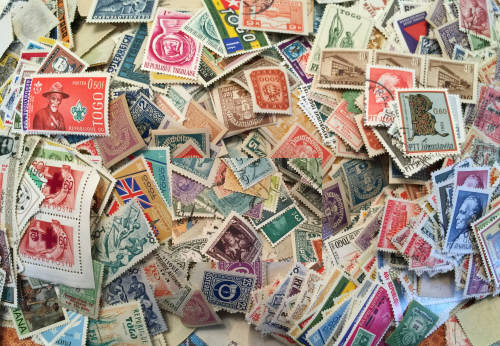
How do you start on something like this?? Stamp collecting has been a passion of mine since I was 6 years old when my grandfather introduced me to the hobby. I was fascinated & it has stuck with me through the years. Occasionally when I go to shows, I will purchase a box lot of stamps. They usually are not expensive, but they will have thousands of stamps & most dealers do not have the time or patience to sort through them. I find sorting & going through accumulations like this a relaxing pastime and a great stress reliever. Almost therapeutic in a way. You forget about everything else & concentrate on the stamps and enjoy the adventure of the hunt. As your collection grows, you will likely find many duplicates when you go through these type of mixtures & kiloware. But be careful, sometimes they are not just duplicates. More on that later. Organizing your stamps forces you to keep track of your collection otherwise you will lose sight of what you have. Stamp collecting software is great for this (EzStamp is perfect for this) So here is my process
- 1) Sort the stamps by country. If you are not sure, put them into a separate pile
- 2) Next I separate them into definitive & commemoratives. Definitive stamps (or regular issues) are much more common. Commemorative issues are usually larger stamps & were issued for a special purpose – ie. They commemorate something like the end of WW II as an example. Commemoratives are usually only available for a short period of time and are issued in smaller quantities than definitives, hence most commemoratives are worth more than definitive & are more sought out by collectors.
- 3) IF the stamps are on paper, place all stamps on COLORED paper into a separate pile as these colored papers can stain the stamps once soaked. Same is true for most colored cancels on stamps.
- 4) Remove any damaged stamps (torn, pulled perfs, stained) & place them into a separate pile
- 5) Next, I sort by denomination. You can also sort them by year, topic or type of stamp service they provided (ie airmails, postage dues etc..).I like to sort by denomination, as I usually use software to identify the stamps. I use SRS and EzStamp, but you can also use a traditional catalog like Scott or Stanley Gibbons
- 6) If you have multiple copies after sorting, select the best copy for your collection. BUT be careful to watch out for varieties. These are most prevalent with the regular issues rather than the commemoratives. Color & perforation varieties are the most common.
- 7) Once I have everything sorted properly, I then scan them in lots & use Ezperf & SRS to identify the stamps & find any perf varieties. In a previous post, I showed you my ‘Best Find Ever’ in a postage lot. I have found countless varieties in mixtures & seemingly worthless collections. It just takes a bit of time and patience and a good set of tools. I find software faster & easier to use. But the traditional methods of a good perforation gauge, a printed catalog(s) and a good color guide will also work. I personally have a very difficult time using the plastic perf gauges. My eyes just cannot focus on such fine lines. Must be getting old (LOL).
- 8) Once I have done this, I then place the best copies into my albums and then I take most of the duplicates (on & off paper) and pass them on to friends and young colelctors (either at shows I attend or donate them to clubs so they can get your collectors involved.). I always try & throw in a nice stamp into the giveaways (say a value of $10-$20) so the new, young collectors can experience the excitement of the hunt. I always tell them “there has to be at least one really good stamp in there” & leave the rest to them !